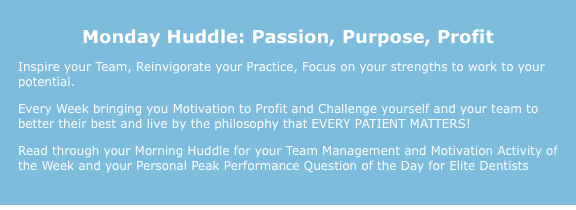As promised, over the next few weeks, I will provide you some specific tactics and strategies to improve your patient outcomes. And by that I mean getting more patients to follow through with treatment and think more favorably about their experience at your practice. This will yield patients who are more likely to refer and who happily pay without using money, insurance or any other excuse as the reason for delaying or declining treatment.
Early in the year, we did a lot of work together talking about trust building and we are going to build on those principles, which are the most important parts to all relationships.
Now, we will break down the four key parts of your patient engagement that really must be micromanaged with detailed protocols set in place that follow the structure we have discussed leading up to today’s huddle.
That said, NO HUMAN INTERACTION can be scripted and protocoled completely. This isn’t pretend, it’s real life and you are dealing with the single biggest variable of them all – a real patient – and they come with no script or outline to follow.
You can however control the variables and dramatically increase your odds of success and therefore improve your patient outcomes; which is better for everyone involved, especially the patient.
So today, I want to talk about beginning with the end in mind for your patients.
I have addressed this many times before by talking about goals, expectations and pre-educating your patients – but that isn’t enough if you really want to get more yeses. You need to dial in your experience leading up to the clinical exam, the time with the doctor and the diagnosing so much so that the patient has already been told basically what is going to happen.
You want to give them the answers they need to know to pass the test that will happen at the end of the visit. That test is: of course saying yes to, scheduling and paying for their pathway to health.
Now some people talk about finding “the motivator” or the “reason why” or the “most important concern” or whatever buzzwords you want to talk about…
BIG PROBLEM
The patient doesn’t have any of these. At least the majority don’t. So if you base the design of patient visits on “what the patient wants,” you are really doing them a total disservice.
Yes, you listen to them. Yes, you ask questions and find out their motivations.
But their motivations may not be optimal health and that’s because they probably don’t know what optimal health is, looks like or should be – and they aren’t supposed to. That’s why we call them “patients!”
Here’s the good news: the proper experience will elevate the patients’ interests in dentistry and compel them to want more for themselves based on your philosophy.
Now, I sure hope that includes a healthy mouth, proper bite, strong dentition, all their teeth and ideally a beautiful smile, in addition to whatever else fits into your clinical philosophy, specialty and interest.
The point of this first strategy and the strict protocol you want to set is that (A) no patient enters the practice without knowing the type of practice they are entering and no patient sees the doctor without being educated about who, what, why this doctor is, does, exists and stand for.
Then it gets even better. (B) We will make life easier for every single team member in the practice by telling the patients what a good patient is, does, decides, etc.
AND, this is the big part, (C) you tell them how they should be thinking about dentistry and what your goals are for every patient in your practice.
YOU GIVE YOUR PATIENTS THEIR MOTIVATIONS to want healthy mouths, all their teeth and beautiful smiles.
This doesn’t mean everyone will want it and that’s fine; but it is your responsibility to give them the chance to want it. You can do this with many things that are obvious… testimonials, before-and-afters, things to show-and-tell. You do it in a way that appeals to the patient by telling them that MOST PATIENTS do not know what to think about dentistry and the importance to your overall health.
Here’s the secret: most wait until it’s too late to have this conversation (which is after the patients think they are being “sold” after they have been diagnosed).
The real strategy here is to do all of this BEFORE they ever open their mouths. You show them what the state of ideal is and why it matters. And you show them what you will be looking for. You always emphasize it as you are doing this now because you have found that patients come in with preconceived ideas or experiences from the past that have given them the wrong perception of dentistry.
Above all else, you tell them what their role in this whole experience and process is supposed to be. Which is to say yes to getting healthy and achieving a state of ideal. Who wouldn’t want that? Everyone would at least want it more if they knew beforehand what it is, versus after when they are on the defense trying to keep you out of their purse and wallet.
Oh, I’m sure you’re wondering… Yes, you can smartly deal with insurance objectives BEFORE they ever come up if you do it in the right way. It’s quite magical. But, you’ll have to wait a few weeks for that strategy.
Today’s huddle should give you a lot to think about and improve.



